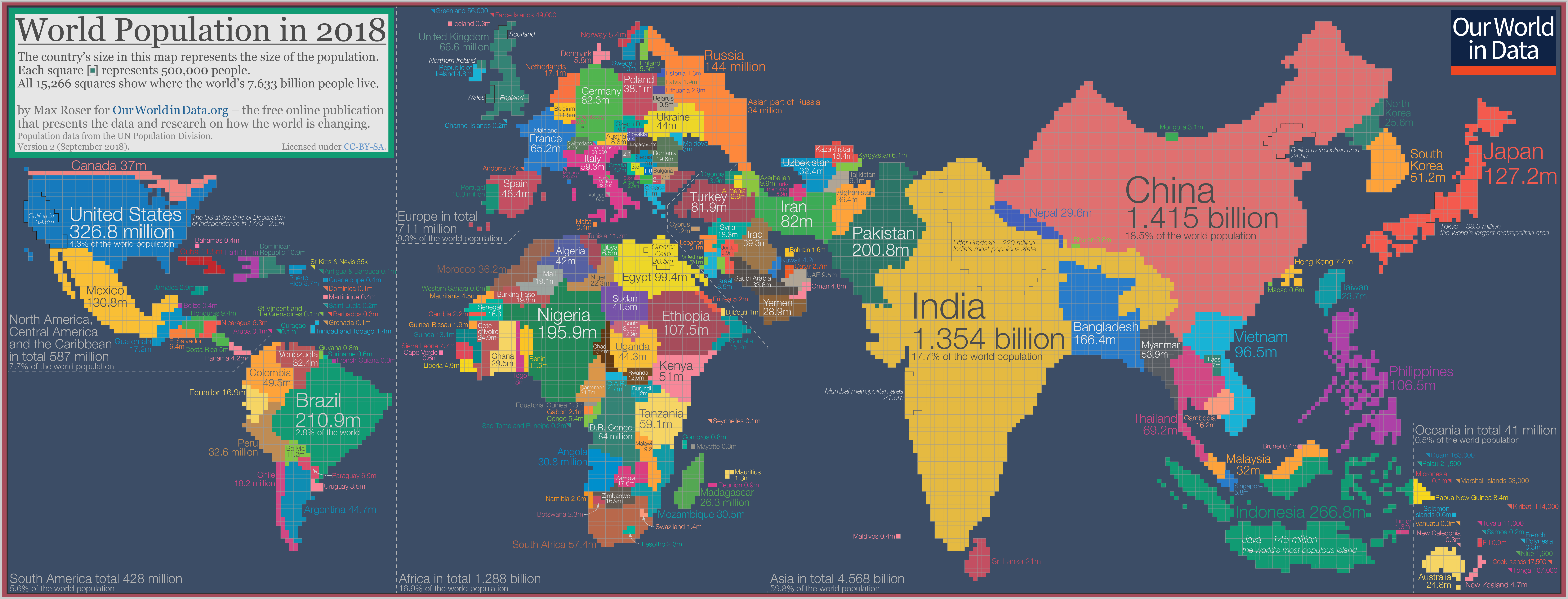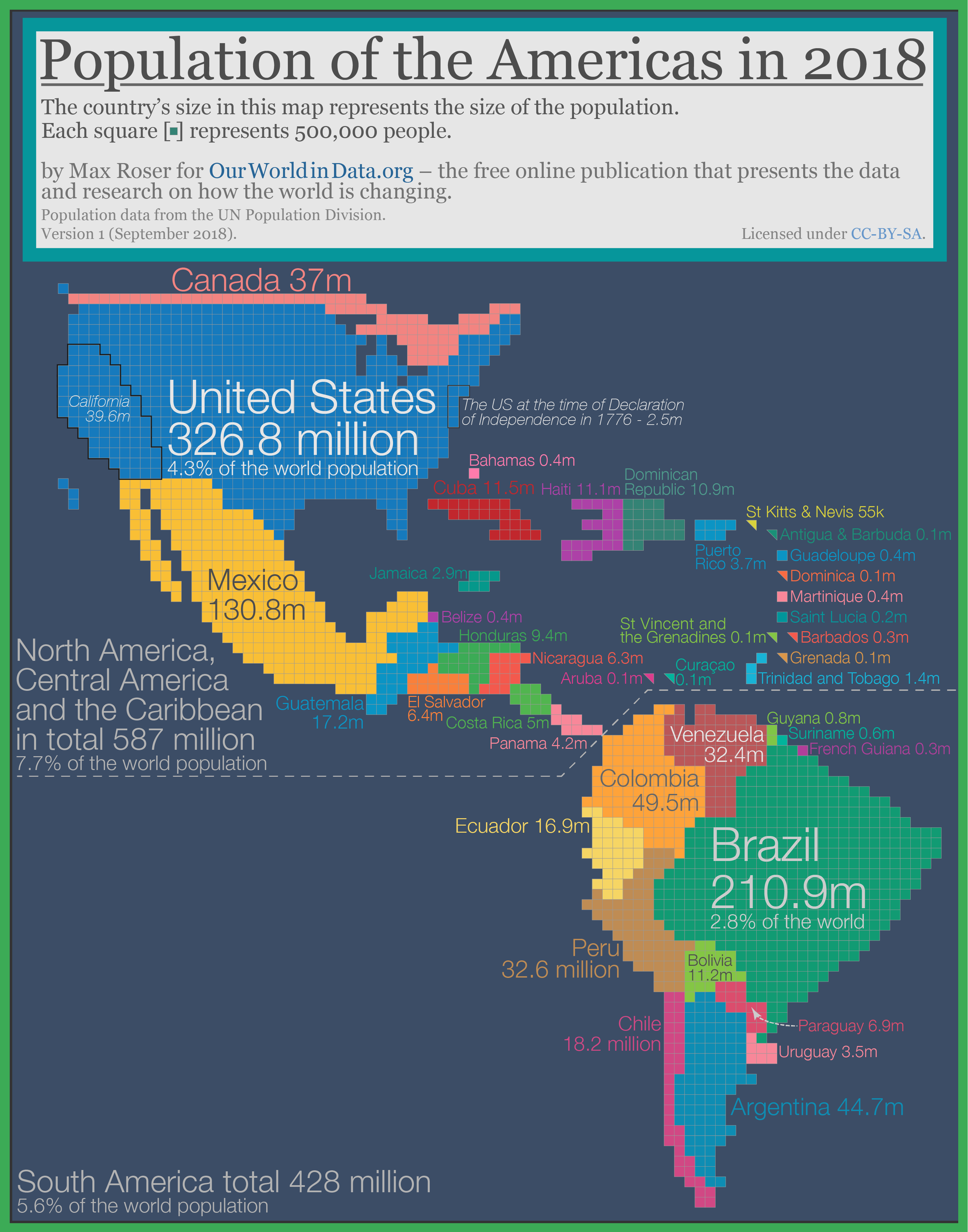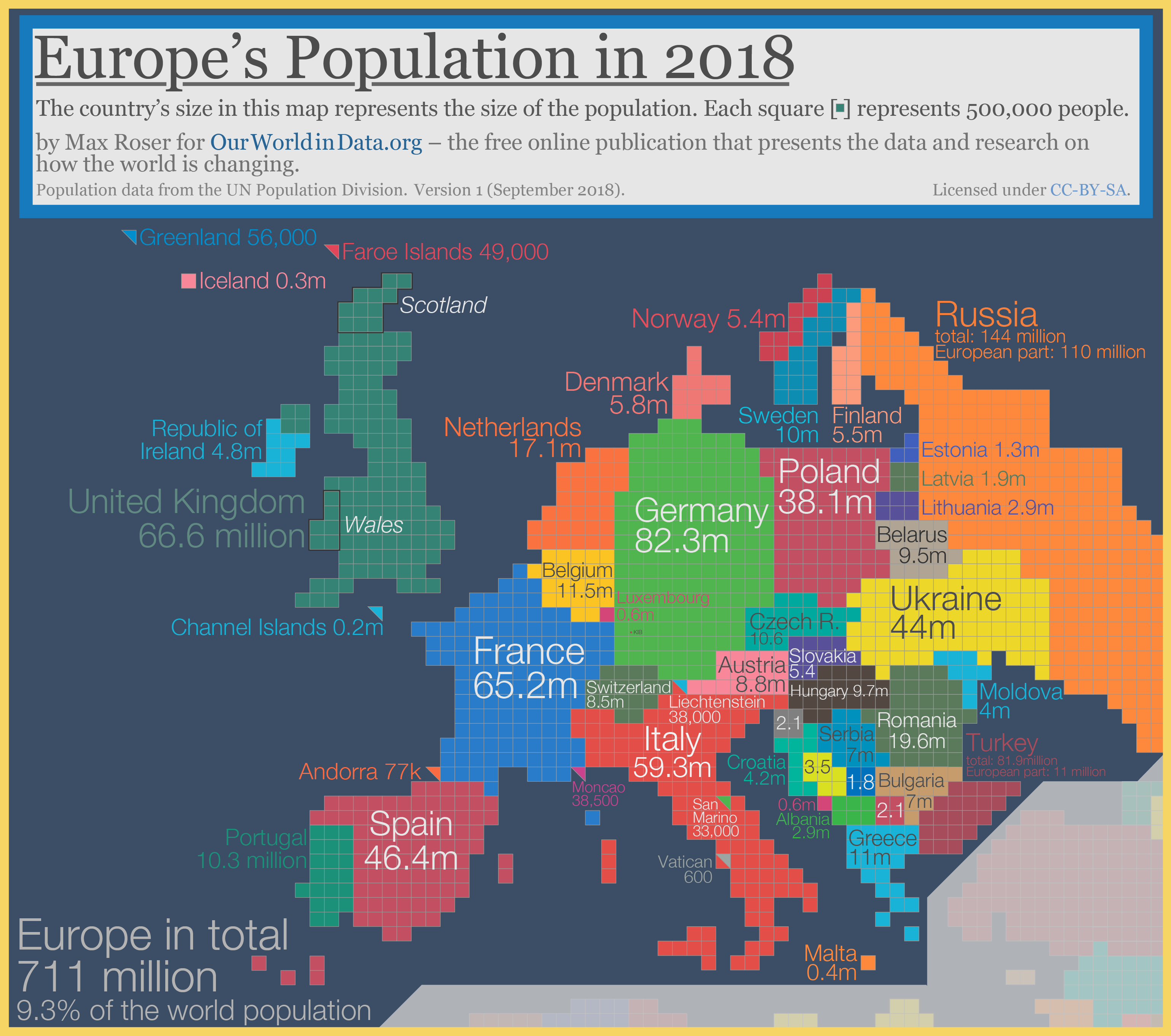Submitted by Taps Coogan on the 28th of September 2018 to The Sounding Line.
Enjoy The Sounding Line? Click here to subscribe for free.
The following maps, from Our World in Data, show the world with countries’ sizes based not on their territory but on their population. By doing so, it provides perspective on the interesting divergences in population density around the world.
Perhaps the most obvious feature of these maps is the massive populations of China and India, which together are larger than the populations of any other continent that excludes them. Similarly out-sized are Japan, the Philippines, Indonesia, Bangladesh, Nigeria, and basically all of South East Asia. At the other end of the spectrum, despite being some of the largest countries in the world in terms of territory, Canada, Australia, and Russia have comparatively minuscule populations.
As Our World in Data notes:
- “The area of Russia takes up 11% of the world’s land and the gigantic country borders both Norway and North Korea. But Russia is home to only less than 2% of the world population and is therefore shrunken in this cartogram to the size of Bangladesh, a country that is smaller than Florida.3“
- “13 countries in the world are home to more than 100 million people: China (1.415 billion), India (1.354 billion), United States (326.8m), Indonesia (266.8m), Brazil (210.9m), Pakistan (200.8m), Nigeria (195.9m), Bangladesh (166.4m), Russia (144m), Mexico (130.8m), Japan (127.2m), Ethiopia (107.5m), Philippines (106.5m).
- A 14th country is very close though, Egypt is expected to reach 100 million next year.
- Together these 13 countries are the home of 4.75 billion people, 62% of the world population.”
All the details below come directly from Our World in Data. Enjoy:
Asia and Oceania
The cartogram below focusses on Asia and Oceania where 6 out of 10 people in the world live.
- Within this world region the population is very unequally distributed. South-East Asia is densely populated while large countries such as Mongolia, Australia, Kazakhstan, and the Asian part of Russia are home to relatively few people. And again within countries we see a very high concentration. The metropolitan area of Beijing has the same population as all of Australia. Tokyo’s population almost equals the population of all of Oceania.
- China and India are by far the most populous countries in the world. If you want to follow what is happening to the world you have to keep track of these two countries:
- More than a third of the world population – 36.2% – live in India and China.
- 60% of all Asians live in China or India.4
- Today, both India and China have a larger population than the entire world population in 1850 (when the world population was around 1.26 billion people).
- But while China and India dominate, other Asian countries are also very populous: seven of the world’s 13 countries with more than 100 million inhabitants are in Asia.
- Population growth in Asia has been rapid in the last decades: The population of Asia has tripled in size since 1950.
- And while some countries in Asia have already reached the last stage of the demographic transition, some others still have rapid population growth ahead. The fertility rate in India has fallen from 6 children per woman in the 1960s to 2.35 children today, but population momentum means that population growth will continue for another 4 decades. According to the UN’s population projection, the population of India is expected to reach 1.68 billion in 2060 and the country is then expected to be the most populous country in the world.
The Americas
The population of the Americas is roughly one billion (1.015 billion). 428 million live in South America and 587 are at home in North America, Central America, and the Caribbean.
- The USA – the third most populous country in the world – is by far the most populous country on the American continent. Its population is roughly as large as the population of the two runner-ups – Brazil and Mexico – combined.
- Canada has a population density of just four people per km² – in the cartogram the second largest country in world (by area) is reduced to not much more than a slim line of squares.
- The shape of the South American countries stays similar to what we would see on a geographical map. This is because the population density across the different South American countries is relatively similar.
- The population of the American continent has increased very rapidly over the course of the last few generations. Historical estimates suggest that in 1820 the population was only around 35.5 million. At the time this made up just 3.4% of the world population.
- Over the last two centuries the population growth rate in the Americas (28-fold) was much faster than in Europe (3-fold), Africa (14-fold), or Asia (6-fold).5
- And some countries in the Americas had even faster population growth. The size of the US population in the 13 founding states at the time of Declaration of Independence, for example, is estimated to have been only 2.5 million.6
Africa
1-in-6 people in the world live in Africa. The second most-populous continent is home to almost 1.3 billion people.
- Two countries have a population of more than 100 million: Nigeria with 195.9 million and Ethiopia with 107.5 million.
- Population density varies hugely on the African continent. The largest African country is Algeria, but it is relatively sparsely populated. At the other end of the spectrum are Rwanda and Burundi. The two neighboring countries are densely populated and are both home to around 12 million people.7
Europe
711 million people live in Europe, less than 10% of the world population.8
- Five European countries have a population that is larger than 50 million: The European part of Russia (110 million), Germany (82.3 m), the UK (66.6m), France (65.2), and Italy (59.3m).
- Some regions of Europe are very densely populated. The Netherlands has a population density of 505 people per km² (compared, for example, to the US with 35 people per km² – see above for the map).
- The population of China is almost exactly twice as large as the population of Europe.
- While the population of Europe is small, the continent is economically very powerful and much richer than most other parts of the world. The per capita output and income of the Swedes for example is 30-fold higher than the per capita output and income of the Indians and 8-times higher than the per capita output or income of the Chinese.9
If you would like to be updated via email when we post a new article, please click here. It’s free and we won’t send any spam.
Would you like to be notified when we publish a new article on The Sounding Line? Click here to subscribe for free.






